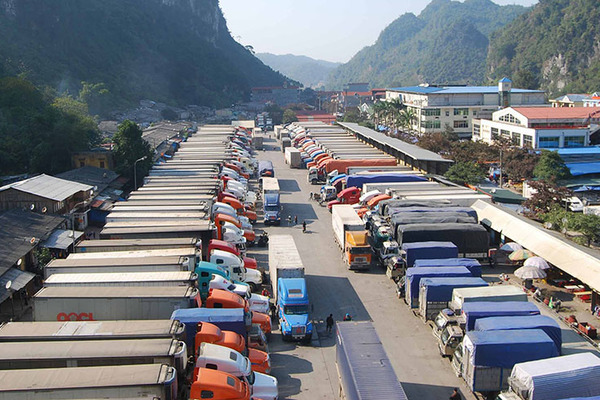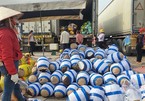
The deadlock at border gates has been a headache for farmers and exporters for years. Despite discussions and working sessions, the problem has not been solved.
Deputy Chair of Lang Son People’s Committee Do Thu Ha said the farm produce deadlock occurred again at the border gate after Tet holiday.
As of March 4, in Lang Son, 1,400 trucks carrying goods, including 800 carrying farm produce, had been waiting to get customs clearance. The province has stopped receiving fresh fruit trucks until March 15.
Ha estimated that the number of fruit trucks to Lang Son from March 15 to April 20 may reach 2,000. Trucks continue flowing to border gates as fruits are the main crop.
To speed up customs clearance, agencies at Lang Son border gate have pursued unprecedented delivery methods. They exchange information hourly and daily with Chinese agencies to ensure the customs clearance process.
There are 13 out of 78 border gates operational. However, since February 26, farm produce has been exported across the LangSon border gate.
Ha said the province has set up a green zone in the border areas, but Vietnam and China have different regulations, so customs clearance has been affected.
Ha said that farmers should increase the processing of farm produce rather than rely on fresh fruit.
Minister of Agriculture and Rural Development Le Minh Hoan said the farm produce deadlock occurred at times in the past, but the situation was worse this year because of the pandemic. He said the problem is due to unprofessional agricultural production.
“In agricultural production, we just try to produce output, and we still don’t have economic thinking. We don’t understand markets well and production and market consumption don’t match.
“We need to find radical solutions which help us master markets and minimize risks,” Hoan said.
Nguyen Thanh Binh, Chair of the Vietnam Fruit and Vegetables Association, said that solutions have been applied but they did not bring the desired effects. Enterprises like to ‘follow the trail’ and ‘do simple things’, so they prefer exporting products across border gates rather than through official channels. They believe that China is an easy market to please but the market has become choosier.
“The Chinese market is no longer easy to please. New requirements on quality and food safety have been set,” he said.
His company has been exporting flower starch to China for many years, but in 2010-2012, when the Chinese Government set new requirements, the company had to use new technology to satisfy new requirements set by partners.
Hoan said China has become a choosy market and Vietnamese exporters have been warned.
When deadlock occurs, questions are raised: Why do exporters rely on one market and not try to diversify markets to ease risks? Why don’t businesses think of processing products and not just export raw products? Why don’t they think of standardizing products to export through official channels?
However, according to Hoan, when trucks get customs clearance, farmers and businesses ‘forget’ these questions and don’t try to find solutions to the problem.
Radical solution needed
Phan Van Chinh, Director of the Ministry of Industry and Trade’s (MOIT) Import-Export Department, said exports across border gates have been maintained because of demand from the two sides and the Chinese tax refund policy.
He said in order to export products through official channels, Vietnam needs to make products that fit the requirements and criteria set by the target market, and negotiate with China on production recognition.
He suggests that businesses think of exporting products by rail in order to ease pressure on roads and waterways, and take full advantage of free trade agreements (FTAs).
In the immediate time, in order to ease farm produce congestion, MOIT has proposed that border provinces build multi-purpose transshipment centers for importers to select, preliminarily process and package goods, and follow customs procedures and quarantine procedures before goods are shipped to China.
Hoan said his ministry would have a working session with agencies this week to build up a specific project on shifting from border trade to official-quota exports to the Chinese market.
The ministry will also create a specific project for the EU market, a high-potential market with 27 countries.
He said that the Ministry of Agriculture and Rural Development (MARD) would accelerate negotiations and the signing of decrees on farm produce recognition, the basis for Vietnam to boost exports through official channels.
He stressed that Vietnam is not the only seller in the Chinese market. It has to compete with other countries which export the same products to China.
Tran Thuong

$50 billion: new annual target for Vietnam’s farm produce
New records in export turnover were set by key export items for January, making the annual target of $50 billion worth of farm exports feasible.

Exports to China still stuck at border, trade stalls
Trucks carrying farm produce are still stuck at border gates, causing exports of some vegetables and fruits to fall sharply.